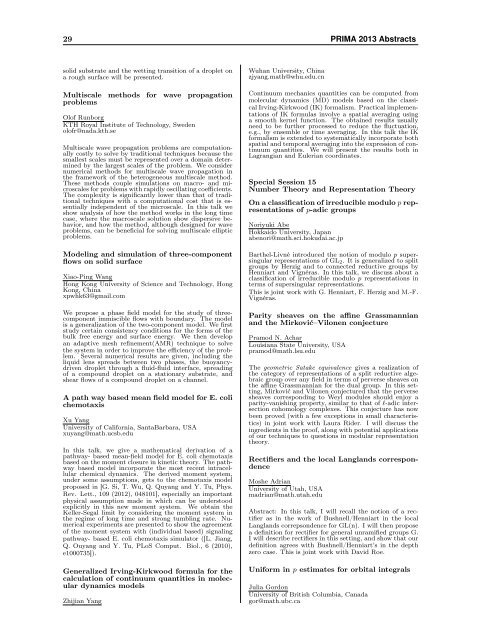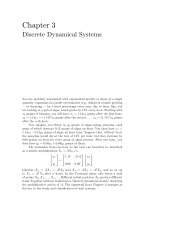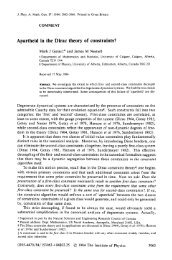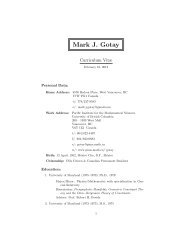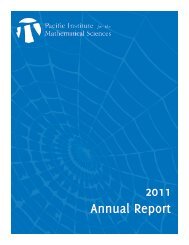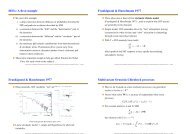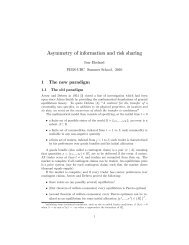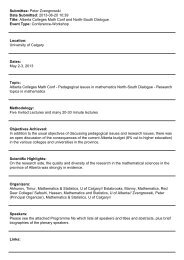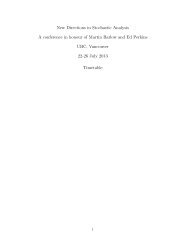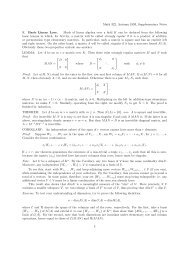29 PRIMA 2013 Abstractssolid substr<strong>at</strong>e and the wetting transition of a droplet ona rough surface will be presented.Multiscale methods for wave propag<strong>at</strong>ionproblemsOlof RunborgKTH Royal Institute of Technology, Swedenolofr@nada.kth.seMultiscale wave propag<strong>at</strong>ion problems are comput<strong>at</strong>ionallycostly to solve by traditional techniques because thesmallest scales must be represented over a domain determinedby the largest scales of the problem. We considernumerical methods for multiscale wave propag<strong>at</strong>ion inthe framework of the heterogeneous multiscale method.These methods couple simul<strong>at</strong>ions on macro- and microscalesfor problems with rapidly oscill<strong>at</strong>ing coefficients.The complexity is significantly lower than th<strong>at</strong> of traditionaltechniques with a comput<strong>at</strong>ional cost th<strong>at</strong> is essentiallyindependent of the microscale. In this talk weshow analysis of how the method works in the long timecase, where the macroscale solution show dispersive behavior,and how the method, although designed for waveproblems, can be beneficial for solving multiscale ellipticproblems.Modeling and simul<strong>at</strong>ion of three-componentflows on solid surfaceXiao-Ping WangHong Kong University of Science and Technology, HongKong, Chinaxpwhk63@gmail.comWe propose a phase field model for the study of threecomponentimmiscible flows with boundary. The modelis a generaliz<strong>at</strong>ion of the two-component model. We firststudy certain consistency conditions for the forms of thebulk free energy and surface energy. We then developan adaptive mesh refinement(AMR) technique to solvethe system in order to improve the efficiency of the problem.Several numerical results are given, including theliquid lens spreads between two phases, the buoyancydrivendroplet through a fluid-fluid interface, spreadingof a compound droplet on a st<strong>at</strong>ionary substr<strong>at</strong>e, andshear flows of a compound droplet on a channel.A p<strong>at</strong>h way based mean field model for E. colichemotaxisXu YangUniversity of California, SantaBarbara, USAxuyang@m<strong>at</strong>h.ucsb.eduIn this talk, we give a m<strong>at</strong>hem<strong>at</strong>ical deriv<strong>at</strong>ion of ap<strong>at</strong>hway- based mean-field model for E. coli chemotaxisbased on the moment closure in kinetic theory. The p<strong>at</strong>hwaybased model incorpor<strong>at</strong>e the most recent intracellularchemical dynamics. The derived moment system,under some assumptions, gets to the chemotaxis modelproposed in [G. Si, T. Wu, Q. Quyang and Y. Tu, Phys.Rev. Lett., 109 (2012), 048101], especially an importantphysical assumption made in which can be understoodexplicitly in this new moment system. We obtain theKeller-Segal limit by considering the moment system inthe regime of long time and strong tumbling r<strong>at</strong>e. Numericalexperiments are presented to show the agreementof the moment system with (individual based) signalingp<strong>at</strong>hway- based E. coli chemotaxis simul<strong>at</strong>or ([L. Jiang,Q. Ouyang and Y. Tu, PLoS Comput. Biol., 6 (2010),e1000735]).Generalized Irving-Kirkwood formula for thecalcul<strong>at</strong>ion of continuum quantities in moleculardynamics modelsZhijian YangWuhan University, Chinazjyang.m<strong>at</strong>h@whu.edu.cnContinuum mechanics quantities can be computed frommolecular dynamics (MD) models based on the classicalIrving-Kirkwood (IK) formalism. Practical implement<strong>at</strong>ionsof IK formulas involve a sp<strong>at</strong>ial averaging usinga smooth kernel function. The obtained results usuallyneed to be further processed to reduce the fluctu<strong>at</strong>ion,e.g., by ensemble or time averaging. In this talk the IKformalism is extended to system<strong>at</strong>ically incorpor<strong>at</strong>e bothsp<strong>at</strong>ial and temporal averaging into the expression of continuumquantities. We will present the results both inLagrangian and Eulerian coordin<strong>at</strong>es.Special Session 15Number Theory and Represent<strong>at</strong>ion TheoryOn a classific<strong>at</strong>ion of irreducible modulo p represent<strong>at</strong>ionsof p-adic groupsNoriyuki AbeHokkaido University, Japanabenori@m<strong>at</strong>h.sci.hokudai.ac.jpBarthel-Livné introduced the notion of modulo p supersingularrepresent<strong>at</strong>ions of GL 2 . It is generalized to splitgroups by Herzig and to connected reductive groups byHenniart and Vignéras. In this talk, we discuss about aclassific<strong>at</strong>ion of irreducible modulo p represent<strong>at</strong>ions interms of supersingular represent<strong>at</strong>ions.This is joint work with G. Henniart, F. Herzig and M.-F.Vignéras.Parity sheaves on the affine Grassmannianand the Mirković–Vilonen conjecturePramod N. AcharLouisiana St<strong>at</strong>e University, USApramod@m<strong>at</strong>h.lsu.eduThe geometric S<strong>at</strong>ake equivalence gives a realiz<strong>at</strong>ion ofthe c<strong>at</strong>egory of represent<strong>at</strong>ions of a split reductive algebraicgroup over any field in terms of perverse sheaves onthe affine Grassmannian for the dual group. In this setting,Mirković and Vilonen conjectured th<strong>at</strong> the perversesheaves corresponding to Weyl modules should enjoy aparity-vanishing property, similar to th<strong>at</strong> of l-adic intersectioncohomology complexes. This conjecture has nowbeen proved (with a few exceptions in small characteristics)in joint work with Laura Rider. I will discuss theingredients in the proof, along with potential applic<strong>at</strong>ionsof our techniques to questions in modular represent<strong>at</strong>iontheory.Rectifiers and the local Langlands correspondenceMoshe AdrianUniversity of Utah, USAmadrian@m<strong>at</strong>h.utah.eduAbstract: In this talk, I will recall the notion of a rectifieras in the work of Bushnell/Henniart in the localLanglands correpsondence for GL(n). I will then proposea definition for rectifier for general unramified groups G.I will describe rectifiers in this setting, and show th<strong>at</strong> ourdefinition agrees with Bushnell/Henniart’s in the depthzero case. This is joint work with David Roe.Uniform in p estim<strong>at</strong>es for orbital integralsJulia GordonUniversity of British Columbia, Canadagor@m<strong>at</strong>h.ubc.ca
30 PRIMA 2013 AbstractsThis talk is about a method, based on model theory, th<strong>at</strong>can be used to get some uniform in p estim<strong>at</strong>es for integralsover p-adic fields in the cases when it is hard to seedirectly how such integrals behave for different places p.One example of such a situ<strong>at</strong>ion is orbital integrals onp-adic groups. Let G be a reductive p-adic group. It wasproved by Harish-Chandra th<strong>at</strong> the orbital integrals, normalizedby the discriminant, are bounded (for a fixed testfunction). However, it is not easy to see how this boundbehaves if we let the p-adic field vary (for example, if thegroup G is defined over a number field F , and we considerthe family of groups G v = G(F v), as v runs over the set offinite places of F ), and how it varies for a family of testfunctions. Using a method based on model theory andmotivic integr<strong>at</strong>ion, we prove th<strong>at</strong> the bound on orbitalintegrals can be taken to be a fixed power (dependingon G) of the cardinality of the residue field. This st<strong>at</strong>ementhas an applic<strong>at</strong>ion to the recent work of S.-W. Shinand N. Templier on counting zeroes of L-functions. Thisproject is joint work with R. Cluckers and I. Halupczok.On the center of Lie algebrasMasoud KamgarpourUniversity of Queensland, Australiamasoud@uq.edu.auI will discuss the center of the universal enveloping algebraof four different kinds of Lie algebras:(1) Harish-Chandra’s description of the centre of a simplealgebra g.(2) Duflo-Kirillov’s description of the centre of an arbitraryfinite dimensional algebra.(3) Center of the algebra of jets g[[t]] and g((t)).(4) Feigin-Frenkel description of center of the vertex Liealgebra associ<strong>at</strong>ed to g, via Langlands dual group.I will then define the notion of quasi-Verma modules forthe abovementioned vertex algebra, and stipul<strong>at</strong>e how theFeigin-Frenkel Center should act on these modules.A homological study of Green polynomialsSyu K<strong>at</strong>oKyoto University, Japansyuchan@m<strong>at</strong>h.kyoto-u.ac.jpWe first explain how to c<strong>at</strong>egorify the Green/Kostka polynomialsof reductive groups. Then, we discuss how theyare rel<strong>at</strong>ed to the relevant orthogonality rel<strong>at</strong>ion of somemodules of affine Hecke algebras and p-adic groups, andtheir consequences.On the structure of Selmer groupsMas<strong>at</strong>o KuriharaKeio University, Japankurihara@m<strong>at</strong>h.keio.ac.jpAs a refinement of Iwasawa theory, which gives a refinedrel<strong>at</strong>ionship than the usual main conjecture betweenSelmer groups and p-adic L-functions, I describethe structure as an abelian group of the classical Selmergroup of an elliptic curve, using modular symbols. I alsotalk on Euler systems and Kolyvagin systems of Gausssum type, which give nontrivial elements in Galois cohomologygroups.On the first Betti number of hyperbolic arithmeticmanifoldsJianshu LiHong Kong University of Science and Technology, HongKong, Chinam<strong>at</strong>om@ust.hkIn the 1970’s Thurston conjectured th<strong>at</strong> every hyperbolicmanifold admits a finite cover with non-zero first Bettinumber. In the arithmetic case, this property is rel<strong>at</strong>edto the congruence subgroup problem for SO(n, 1). Forarbitrary dimension n there are two types of arithmetichyperbolic manifolds, which arise from either quadr<strong>at</strong>icforms over totally real number fields, or skew-hermitianforms over certain qu<strong>at</strong>ernion algebras. In 1976 Millsonproved Thurston’s conjecture for the first type of arithmetichyperbolic manifolds using geometric methods. Forthe second type of manifolds, similar results were establishedin the 1990’s .In this talk we will briefly review this history, and discussan improved version of an old construction which leads tosome modest rel<strong>at</strong>ed results. We will also discuss somerel<strong>at</strong>ed open problems.On the elliptic part of the trace formula for˜Sp(2n)Wen-Wei LiChinese Academy of Sciences, Chinawwli@m<strong>at</strong>h.ac.cnIn this talk, I will introduce the stabiliz<strong>at</strong>ion of Arthur-Selberg trace formula for reductive groups and its applic<strong>at</strong>ions,then proceed to its generaliz<strong>at</strong>ion to the metaplectictwofold cover ˜Sp(2n) of Sp(2n). Based on therecent progress on geometric transfer and the invarianttrace formula for metaplectic group, I will explain thestabiliz<strong>at</strong>ion of the elliptic terms in the trace formula of˜Sp(2n).Endoscopic classific<strong>at</strong>ion of automorphic represent<strong>at</strong>ionsof classical groupsChung Pang MokMcMaster University, Canadacpmok@m<strong>at</strong>h.mcmaster.caWe will give an exposition of the recent works on endoscopicclassific<strong>at</strong>ion of automorphic represent<strong>at</strong>ions forclassical groups. Some recent arithmetic applic<strong>at</strong>ions ofthe endoscopic classific<strong>at</strong>ion will be discussed.Twisted spectral transfer for real groupsPaul MezoCarleton University, Canadamezo@m<strong>at</strong>h.carleton.caKottwitz and Shelstad generalized the framework of endoscopyto include twisting by group automorphisms orcentral characters. This generaliz<strong>at</strong>ion contained conjecturalidentities between orbital integrals, constituting <strong>at</strong>ransfer from functions on a group to functions on oneof its endoscopic groups. This geometric transfer has recentlybeen proven by Shelstad. Dual to geometric transferis spectral transfer, which is a collection identities betweencharacters of L-packets of a group and one of itsendoscopic groups. We show how some work of Bouaziz,Duflo and Shelstad may be adapted to the twisted endoscopyof real reductive groups in order to achieve spectraltransfer.Zelevinsky involution and l-adic cohomologyof Rapoport-Zink spacesYoichi MiedaKyoto University, Japanmieda@m<strong>at</strong>h.kyoto-u.ac.jp
- Page 2 and 3:
1PRIMA 2013-Table of ContentsTable
- Page 4 and 5:
3PRIMA 2013-OrganizationOrganizatio
- Page 6 and 7:
5PRIMA 2013-OrganizationYoshikazu G
- Page 8 and 9:
7PRIMA 2013-Useful InformationUsefu
- Page 10 and 11:
9PRIMA 2013-Useful InformationTaxi:
- Page 12 and 13:
11PRIMA 2013-Useful Informationmath
- Page 14 and 15:
13PRIMA 2013 Program-Schedule-at-a-
- Page 16 and 17:
15PRIMA 2013 Program-Monday, June 2
- Page 18 and 19:
17PRIMA 2013 Program-Monday, June 2
- Page 20 and 21:
19PRIMA 2013 Program-Monday, June 2
- Page 22 and 23:
21PRIMA 2013 Program-Monday, June 2
- Page 24 and 25:
23PRIMA 2013 Program-Tuesday, June
- Page 26 and 27: 25PRIMA 2013 Program-Tuesday, June
- Page 29 and 30: 28PRIMA 2013 Program-Tuesday, June
- Page 31 and 32: 30PRIMA 2013 Program-Tuesday, June
- Page 33 and 34: 32PRIMA 2013 Program-Wednesday, Jun
- Page 35 and 36: 34PRIMA 2013 Program- Thursday, Jun
- Page 37 and 38: 36PRIMA 2013 Program- Thursday, Jun
- Page 39 and 40: 38PRIMA 2013 Program- Thursday, Jun
- Page 41 and 42: 40PRIMA 2013 Program- Thursday, Jun
- Page 43 and 44: 42PRIMA 2013 Program- Friday, June
- Page 45 and 46: 44PRIMA 2013 Program- Friday, June
- Page 48 and 49: 1 PRIMA 2013 AbstractsContents1 Pub
- Page 50 and 51: 3 PRIMA 2013 Abstractsof subfactors
- Page 52 and 53: 5 PRIMA 2013 AbstractsprocessesXu S
- Page 54 and 55: 7 PRIMA 2013 AbstractsIn this talk
- Page 56 and 57: 9 PRIMA 2013 Abstractsindependently
- Page 58 and 59: 11 PRIMA 2013 AbstractsEnumerating,
- Page 60 and 61: 13 PRIMA 2013 AbstractsRyuhei Uehar
- Page 62 and 63: 15 PRIMA 2013 AbstractsIn this talk
- Page 64 and 65: 17 PRIMA 2013 AbstractsSpecial Sess
- Page 66 and 67: 19 PRIMA 2013 Abstractscritical slo
- Page 68 and 69: 21 PRIMA 2013 AbstractsSpecial Sess
- Page 70 and 71: 23 PRIMA 2013 Abstractsstrictly awa
- Page 72 and 73: 25 PRIMA 2013 AbstractsPedram Hekma
- Page 74 and 75: 27 PRIMA 2013 Abstractsis well-know
- Page 78 and 79: 31 PRIMA 2013 AbstractsRapoport-Zin
- Page 80 and 81: 33 PRIMA 2013 Abstractssense. Our a
- Page 82 and 83: 35 PRIMA 2013 AbstractsIn an econom
- Page 84 and 85: 37 PRIMA 2013 AbstractsKyoto Univer
- Page 86 and 87: 39 PRIMA 2013 AbstractsAlexander Mo
- Page 88 and 89: 41 PRIMA 2013 AbstractsOsamu SaekiK
- Page 90 and 91: 43 PRIMA 2013 Abstractsopen Delzant
- Page 92 and 93: 45 PRIMA 2013 AbstractsJian ZhouTsi
- Page 94 and 95: 47 PRIMA 2013 AbstractsJiaqun WeiNa
- Page 96 and 97: 49 PRIMA 2013 Abstractsthe end of 2
- Page 98 and 99: 51 PRIMA 2013 AbstractsJongyook Par
- Page 100 and 101: 53 PRIMA 2013 AbstractsPancyclicity
- Page 102 and 103: 55 PRIMA 2013 AbstractsEfficient nu
- Page 104 and 105: 57 PRIMA 2013 Abstractsand fountain
- Page 106: 59 PRIMA 2013 Abstractsformula esti


